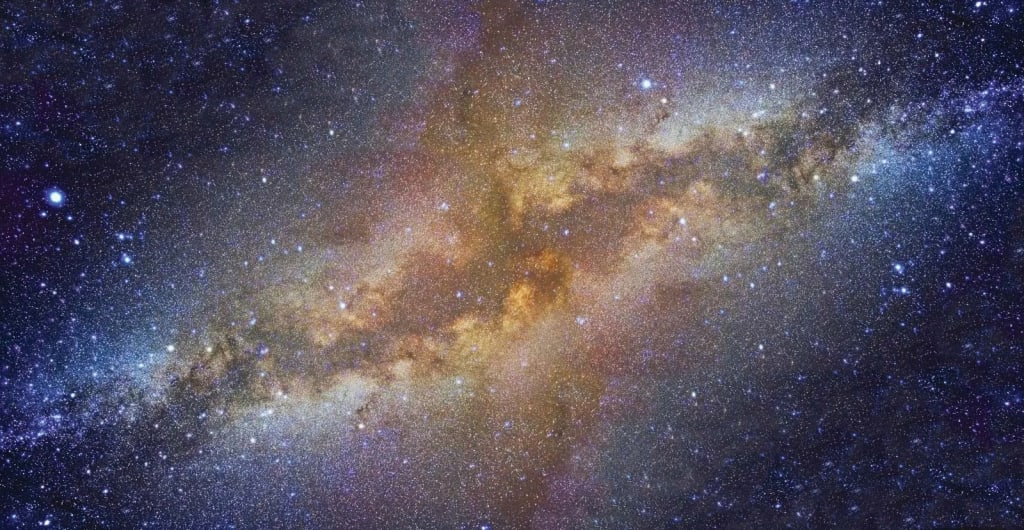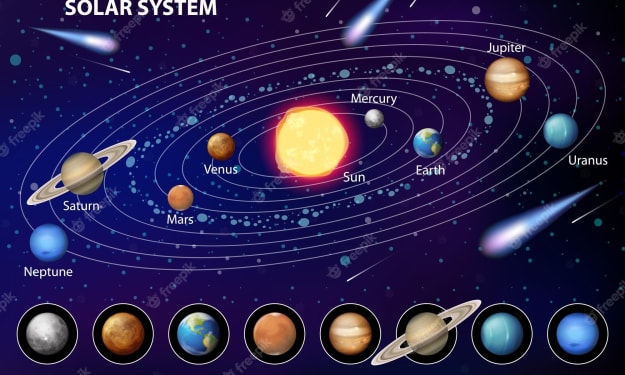
The Milky Way Galaxy is the galaxy in which our Solar System resides. It is a barred spiral galaxy, meaning it has a central bar-shaped structure with spiral arms extending outward from it. The Milky Way is estimated to be about 100,000 to 120,000 light-years in diameter and contains billions of stars, along with various other celestial objects such as planets, asteroids, comets, and interstellar dust.
Key features of the Milky Way include:
Central Bulge: The central bulge is a dense region at the center of the galaxy, containing a high concentration of stars. This region is surrounded by a barred structure made up of stars, gas, and dust.
Spiral Arms: The Milky Way has several spiral arms that extend outward from the central bar. These arms are composed of young stars, star-forming regions, and interstellar gas and dust. The Sun is located in a minor arm called the Orion-Cygnus Arm or Local Spur.
Disk: The galaxy's flattened, rotating disk contains the spiral arms and is where most of the stars and interstellar matter are found. The Sun is located within this disk.
Halo: The halo is a spherical region surrounding the central bulge and disk. It contains older stars and globular clusters. The halo also likely contains dark matter, which is a form of matter that does not emit light or electromagnetic radiation but exerts gravitational influence.
Dark Matter: Although not directly observable, scientists believe that dark matter makes up a significant portion of the Milky Way's mass. Its presence is inferred from its gravitational effects on visible matter and the motion of stars within the galaxy.
Sagittarius A: Supermassive Black Hole*: At the center of the Milky Way lies a supermassive black hole called Sagittarius A*. It has a mass of about 4 million times that of our Sun and is surrounded by a compact cluster of stars.
Stellar Population: The Milky Way contains a wide range of stellar populations, from young and massive stars in the spiral arms to older stars in the galactic halo.
Galactic Halo: The halo contains older stars, globular clusters, and other objects that orbit the galaxy's center. It is less densely populated than the disk.
Dust and Gas: The interstellar medium within the Milky Way includes dust and gas, which are the building blocks for new stars and planetary systems. Regions of active star formation are often seen as bright nebulae.
The Milky Way is just one of billions of galaxies in the observable universe. Studying the Milky Way helps scientists gain insights into the formation, evolution, and behavior of galaxies in general. However, our understanding of the Milky Way's detailed structure and dynamics continues to evolve as new observations and research methods are developed..
The Milky Way consists of a bar-shaped core region surrounded by a warped disk of gas, dust and stars. The mass distribution within the Milky Way closely resembles the type Sbc in the Hubble classification, which represents spiral galaxies with relatively loosely wound arms. Astronomers first began to conjecture that the Milky Way is a barred spiral galaxy, rather than an ordinary spiral galaxy, in the 1960s. These conjectures were confirmed by the Spitzer Space Telescope observations in 2005 that showed the Milky Way's central bar to be larger than previously thought.
The Sun is 25,000–28,000 ly (7.7–8.6 kpc) from the Galactic Center. This value is estimated using geometric-based methods or by measuring selected astronomical objects that serve as standard candles, with different techniques yielding various values within this approximate range . In the inner few kiloparsecs (around 10,000 light-years radius) is a dense concentration of mostly old stars in a roughly spheroidal shape called the bulge. It has been proposed that the Milky Way lacks a bulge due to a collision and merger between previous galaxies, and that instead it only has a pseudobulge formed by its central bar. However, confusion in the literature between the (peanut shell)-shaped structure created by instabilities in the bar, versus a possible bulge with an expected half-light radius of 0.5 kpc, abounds
About the Creator
Enjoyed the story? Support the Creator.
Subscribe for free to receive all their stories in your feed. You could also pledge your support or give them a one-off tip, letting them know you appreciate their work.






Comments
There are no comments for this story
Be the first to respond and start the conversation.